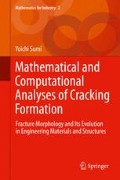Abstract
Stress concentration in an elastic body may be caused mainly by the two-mechanisms i.e., concentrated forces acting to a body and geometrical discontinuities of a body such as holes or abrupt change of its surface geometry. The local stress increase induced by stress concentration sometimes causes the initiation of a fatigue crack in a structure, which must be carefully examined for engineering design. We shall first discuss the stress concentration by a concentrated applied force. Then, stress concentrations due to a circular hole and an elliptic hole are calculated by using the Airy’s stress function. The general solution in a polar coordinate system derived in the previous chapter and the complex potential method discussed in Appendix A will be utilized to obtain the solutions, where the latter is essential for the analysis of elliptic hole problem, which is closely related to a crack problem to be explained in the next chapter.
Access this chapter
Tax calculation will be finalised at checkout
Purchases are for personal use only
References
Inglis CE (1913) Stresses in a plate due to the presence of cracks and sharp corners. Trans Roy Inst Naval Architects 55–1:219–241
Neuber H (1937) Kerbspannungslehre: grundlagen fur genaue spannugsrechnung. Springer, Berlin
Peterson RE (1953) Stress concentration design factors. Wiley, New York
Raven FA (1946) Theory of notch stresses: principle of exact stress calculation, (translation of Neuber, 1937). U.S. Navy Department, David Taylor Model Basin, Washington, D.C.
Stevenson AC (1945) Complex potentials in two-dimensional elasticity. Proc Roy Soc Lond A 184:129–179
Timoshenko SP, Goodier JN (1970) Theory of elasticity, 3rd edn. McGraw-Hill, New York
Author information
Authors and Affiliations
Rights and permissions
Copyright information
© 2014 Springer Japan
About this chapter
Cite this chapter
Sumi, Y. (2014). Stress Concentration Problems. In: Mathematical and Computational Analyses of Cracking Formation. Mathematics for Industry, vol 2. Springer, Tokyo. https://doi.org/10.1007/978-4-431-54935-2_2
Download citation
DOI: https://doi.org/10.1007/978-4-431-54935-2_2
Published:
Publisher Name: Springer, Tokyo
Print ISBN: 978-4-431-54934-5
Online ISBN: 978-4-431-54935-2
eBook Packages: EngineeringEngineering (R0)

